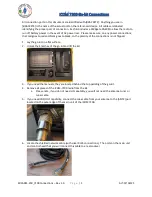
Page 19
FT-410 O
peraTiOn
M
anual
c
Onvenience
F
eaTures
AGc
(
t
ool
for
c
omfortAble
ANd
effective
r
eceptioN
)
The AGC system is designed to help compensate for fading and other propagation effects, with
characteristics that can be of particular value on each operating mode. The basic objective of AGC is to
maintain a constant audio output level once a certain minimum threshold of signal strength is achieved.
Press the [
AGC
] button repeatedly to select the desired
receiver-recovery time constant. For most operations,
we recommend the “AUTO” mode.
14.195.000
M-012
[AGC]
button
Block Diagram
Auto
Sets the receiver-recovery time automati-
cally depending on the operating mode.
Fast
Sets the receiver-recovery time to fast.
This mode is suitable for CW/DATA recep-
tion.
Slow
Sets the receiver-recovery time to slow.
This mode is suitable for SSB/AM recep-
tion.
n
OTe
:
Normally, the “Auto” selection is satisfactory for most situations, but in the event of operation on a crowded
band where you wish to receive a weak signal, you may wish to change the setting (to FAST, for example).
A B C
Shift
(
i
NterfereNce
r
ejectioN
)
IF Shift allows you to vary the DSP filter passband higher or lower, without changing the pitch of the incoming
signal, so as to reduce or eliminate interference. Because the carrier tuning frequency is not varied, there is
no need to re-tune the operating frequency when eliminating the interference.
Rotate the [
SHIFT
] knob to the left or right to reduce
the interference.
Referring to Figure “
A
”, note the depiction of the IF DSP
filter as the thick line, with the [
SHIFT
] knob in the 12
o’clock position. In Figure “
B
”, an interfering signal has
appeared inside the original passband. In Figure “
C
”, you
can see the effect of rotating the [
SHIFT
] knob to reduce
the interference level by moving the filter passband so that
the interference is outside of the passband.
14.195.000
M-012
[SHIFT]
knob













































